Garage doors may look simple, but they have a complex system inside. Many garage door components work together. The torsion springs help to balance the door’s weight. The HomeKit garage door opener has advanced mechanics. Every part is important for the garage door parts diagram to function well.
Key Takeaways
- Understanding the anatomy of your garage door parts garage diagram can be very helpful during repairs.
- A garage door is made of many different components that work together to ensure smooth operation.
- The main components are the door itself (panels/sections), the tracks, the rollers, the springs, and the opener.
- By familiarizing yourself with a garage door parts diagram, you can better understand how each component contributes to the system’s overall functionality.
- This knowledge empowers you to identify potential issues and seek timely repairs, ensuring the safety and longevity of the garage door system.
Understanding Garage Door Parts Diagram
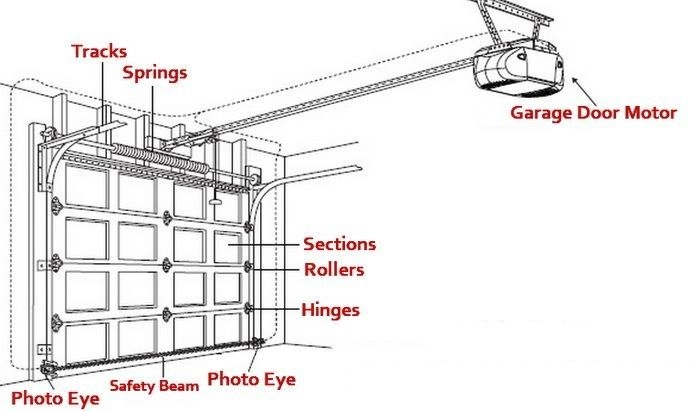
Before delving into a garage door parts diagram, understanding its functionality is key. The main components include torsion springs that balance the door’s weight, aiding smooth operation for the opener. The springs store energy as the door closes, helping in the lifting process for the opener.
1. The Role of Each Component
Understanding a garage door parts diagram starts with knowing the function of each part. Garage door Torsion springs support the weight, aiding the opener. Strong metal tracks guide rollers for smooth movement. These components work together for seamless operation, with additional parts enhancing safety and performance.
2. How Components Work Together?
The movement of the door is like a team effort among different parts. The garage door opener, which you can start with a remote or wall switch, begins the process of opening.
The key to lifting the door is the mechanical energy in the torsion springs. When the opener works, it lets go of the tension in the springs. This helps the springs unwind and lift the door.
This teamwork between the opener and springs makes sure the door moves smoothly and easily. It helps reduce stress on the opener and makes all parts last longer.
Garage Door Parts Diagram
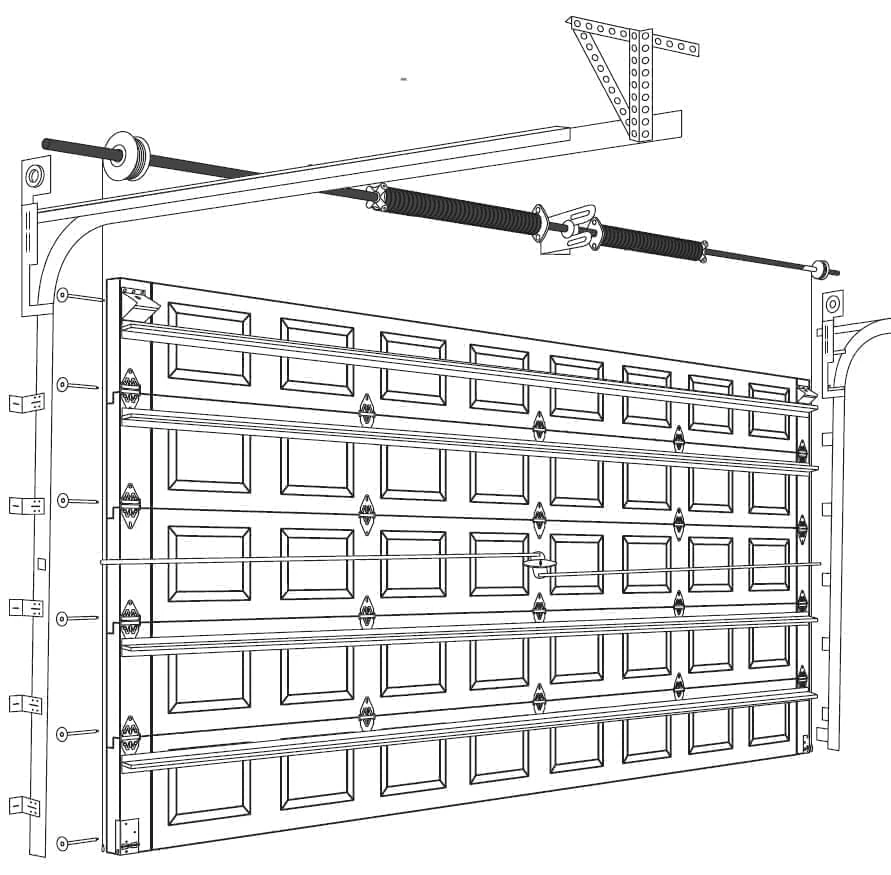
Navigating garage doors is much simpler with a garage door parts diagram. This visual tool helps you break down the system into easy-to-understand pieces. It shows how each part works together.
For instance, the tracks guide the rollers. The springs support the weight. The opener is what drives the door up and down. A diagram gives you a clear view of how all these parts fit together. Let’s take a closer look at some of these components.
3. Garage door frame
The garage door parts diagram is very important. It gives structural support to the whole system. It has horizontal tracks that run along the ceiling of the garage. It also has vertical tracks on the side of the garage door.
The horizontal tracks hold the weight of the door as it goes up and down. They are usually fixed to the ceiling joists. The vertical tracks help the rollers move. This ensures the door opens and closes smoothly.
These vertical tracks are attached to the walls on both sides of the opening. They guide the door’s movement.
4. Garage door tracks

Garage door tracks are the metal rails that garage door rollers move along. They help the door open and close smoothly. These tracks are usually made of galvanized steel. They are fixed to the walls and ceiling of the garage.
At the top, the tracks have a curve. This allows the door to change from a vertical position to a horizontal one without trouble. The state and positioning of the tracks are very important for how the door works.
If the tracks are bent or not aligned properly, it can cause friction. This can lead to jerkiness or even derailment of the door.
Checking the tracks often for signs of damage, debris, or misalignment can stop big problems. It can also help make your garage door system last longer.
5. Garage door brackets
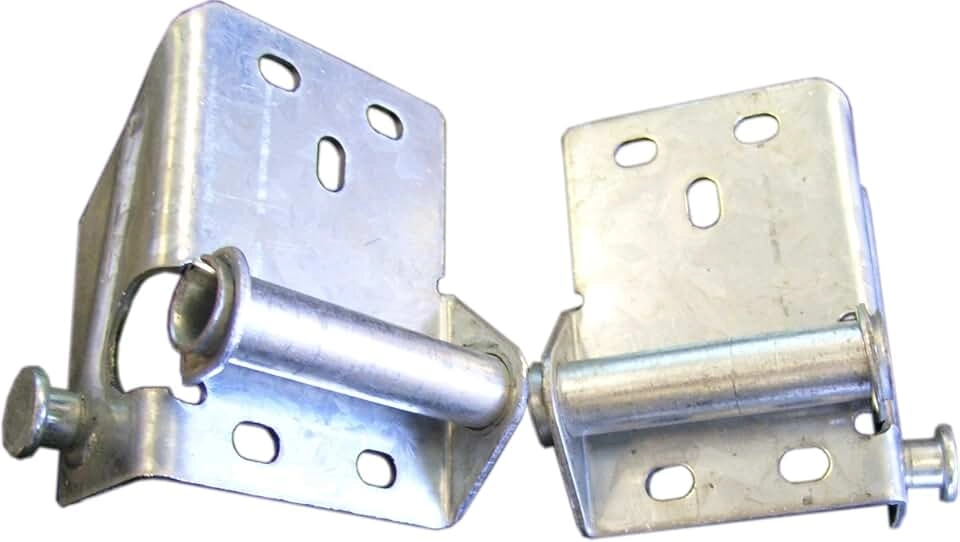
Garage door brackets connect the door to tracks and springs, distributing weight evenly. They endure stress during door movement, especially with heavy doors. Regularly inspect and promptly replace damaged brackets to ensure safety and longevity.
6. Garage door hanger kits
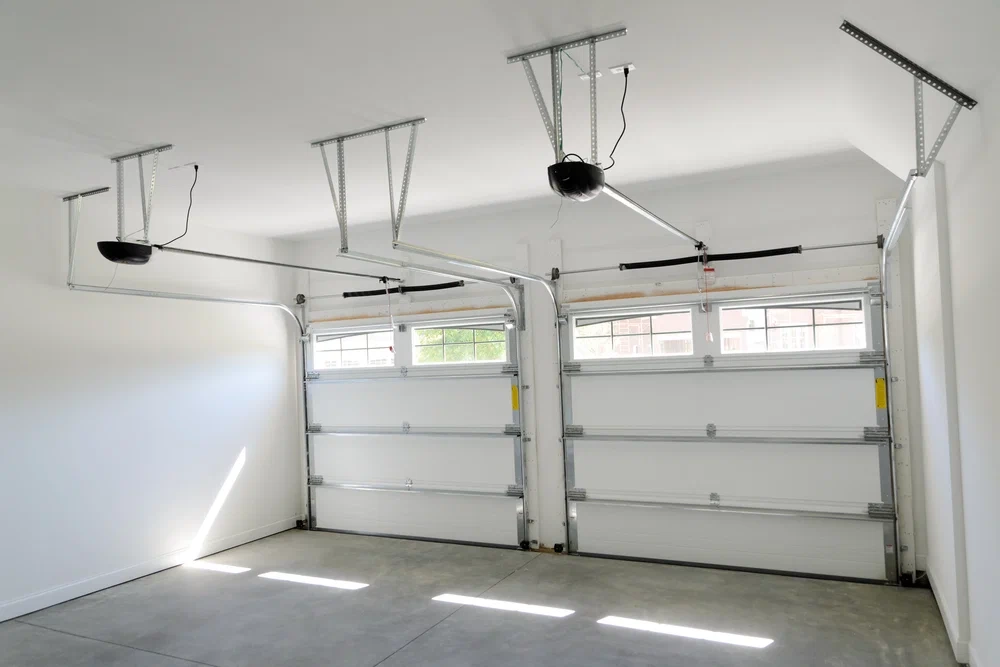
Garage door hanger kits are crucial for attaching garage door tracks securely to the ceiling, providing essential structural support. These kits typically include heavy-duty steel brackets and fasteners designed to handle the door’s weight and movement.
Proper installation and regular checks are vital to prevent misalignment, which can lead to noisy operation, increased wear, and safety hazards.
7. The bottom rail
The bottom rail is at the door’s bottom, crucial for supporting the garage door. It keeps the door shut and bears its weight. Roller brackets hold rollers moving on tracks for smooth opening and closing. Damage to the bottom rail, like bending or rusting, can affect weight distribution and door functionality.
Check the bottom rail regularly for damage. Promptly fix any issues to prevent further damage and safety hazards.
Parts of a Garage Door
The garage door has many important parts that people often forget about. It is usually made from separate panels that are connected by hinges. This setup helps the door bend and move along the tracks easily.
Other key parts are the weatherstripping that fills the gaps around the edges, handles for opening it by hand, and windows that can let in light and make it look nicer.
8. Garage Door Cable Drum

The garage door cable drum is a round part that works with the torsion spring system. Its main job is to handle the tension and movement of the cables that lift and lower the garage door.
When the door moves, the cables at the bottom corners of the door wrap or unwrap around the cable drum. The drum spins, controlled by the torsion springs, to keep the door moving smoothly and evenly during use.
Over time, the cable drum can get worn out, which might affect how well the garage door works. It’s important to regularly check the cable drum for signs of damage like cracks or loose cables. This is key for keeping the garage door operating safely and smoothly.
9. Garage Door Torsion Spring

Garage door torsion springs are strong metal coils that are attached to a shaft above the garage door. They help balance the door’s weight, making it easier to open and close.
These springs hold mechanical energy as the door shuts, winding tighter and tighter. When you open the door, this energy is let go, helping to lift the heavy door and keeping the movement smooth and controlled. Remember, torsion springs are tightly wound and can be very dangerous if not handled correctly.
It is best to get help from a professional for any problems or changes with the torsion springs.
10. Garage Door Trolley
The garage door trolley connects the door to the automatic opener, allowing smooth movement on tracks. It has a carriage moving along a rail on the ceiling, connecting to the opener’s drive system.
The trolley slides when the opener is activated, opening or closing the garage door efficiently. This component is crucial for door movement, making it convenient to access your garage.
11. Garage Door Belt/Chain

The door’s belt/chain connects the motor to move it, changing spinning force into straight motion for door operation. Chain drives are sturdy but noisy, while belt drives use a quiet rubber belt with steel cords for smooth operation at a higher cost.
Choosing between belt and chain drives depends on personal preference. Belts are quieter, while chains are more durable and cost-effective.
12. Garage Door Opener or Motor
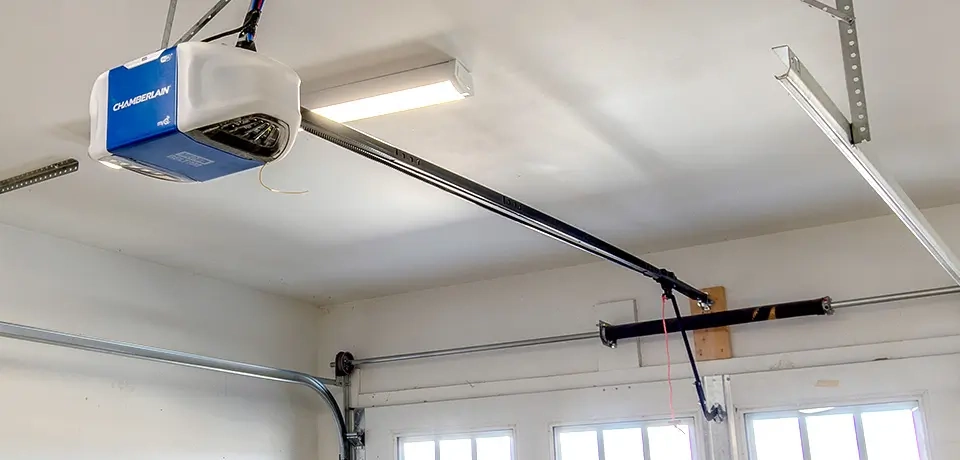
At the center of any modern garage door system is the automatic opener. This device allows you to open and close your door easily. Usually, it is installed on the ceiling of the garage. It has the power to lift the door with just a push of a button.
While the opener starts the door’s movement, it does not lift it alone. The garage door springs help balance the door’s weight. This teamwork leads to smooth and controlled operation. It also lessens the strain on the opener’s motor, making it last longer.
When choosing a garage door opener, think about the door’s size, weight, and material. You should also look at features like horsepower, drive type (chain, belt, or screw), and options for smart home use. Talking to an expert can help you find the best opener for your garage door and needs.
13. Garage Door Jambs
Garage door jambs are the vertical pieces that are on each side of the garage door opening. Many people overlook these parts, but they are very important. They provide support for the garage door system and help keep the door panels aligned.
The jambs are usually made from strong materials like wood or steel. They can handle the weight and stress put on the door while it opens and closes. They also hold the garage door tracks, hinges, and weatherstripping to keep everything working well and ensure the door moves smoothly.
Additionally, the jambs make the garage more secure. They act as a barrier against forced entry. Their strong build, along with the door panels and locking systems, helps keep your items safe from thieves.
14. Garage Door Struts

Garage door struts are horizontal bars made of steel. They are put on the inside of the garage door panels. Their job is to give extra support, especially for wider doors or ones that are heavy.
These struts help spread the weight of the door evenly. This stops the panels from sagging or bending over time. This is very important for doors that face strong winds, heavy snow, or are used often. The added support helps keep the door’s shape and makes it safer.
Besides holding the structure, struts also make the garage door more stable. They lessen movement and vibrations when the door is used. This means a quieter and smoother closing experience.
Check the struts regularly for any damage. Look for bending or rust. Replacing them when needed will help your garage door work well for a long time and stay safe.
15. Garage Door Sensor

Garage door sensors use infrared technology to detect obstructions, ensuring safety by halting and reversing the door’s operation when interrupted. Regular maintenance is crucial to keep them functioning properly.
Clean and align sensor lenses to avoid malfunctions and ensure optimal safety performance. Understanding sensor functionality helps troubleshoot minor issues for safe and efficient garage door operation.
16. Garage Door Emergency Release
The garage door emergency release is an important safety feature. It helps you open or close your garage door manually when the automatic opener is not working. Usually, you will see a bright red cord or handle hanging from the opener’s trolley. When you pull it, the door disconnects from the opener’s drive system, so you can lift it by hand.
This feature is very useful during power outages, if the opener stops working, or if someone or something gets stuck under the closing door. It is important to know how to use the emergency release quickly and safely in emergencies.
Make sure you know where it is located and how it works by checking your garage door opener’s manual. It’s a good idea to test the emergency release sometimes to make sure it works properly. This way, you will feel comfortable using it if you ever need it. Remember, safety is the top priority!
17. Weather Stripping
Properly installed weatherstripping on the sides and bottom of your garage door is key for keeping your garage sealed and energy-efficient. This flexible material fills the gaps between the door and its frame. It helps keep out drafts, moisture, debris, and pests.
By stopping outside air from getting in and the conditioned air from escaping, weatherstripping helps make your garage comfortable all year. This means less heat loss in winter and less heat gain in summer, which can lead to lower energy bills.
Over time, weatherstripping can wear out, become brittle, or get damaged, which makes it less effective. It’s smart to check it every year for any signs of wear and to replace it when necessary. This helps you maintain a comfortable and energy-efficient garage.
18. Garage Door Hinges
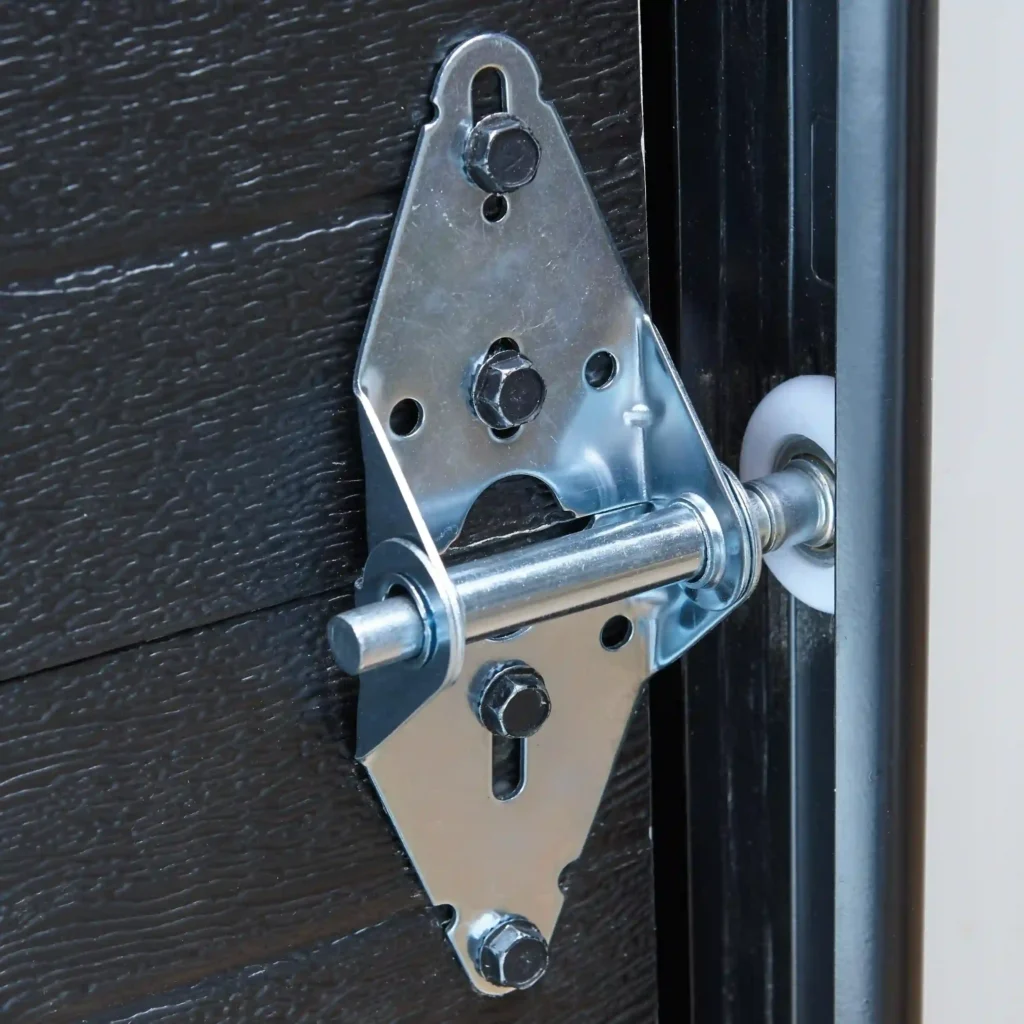
Garage door hinges might not get much attention, but they play an important role. They help the door move smoothly. These metal parts connect to the door panels. They allow the door to change from a vertical position to a horizontal one when it opens and closes.
The strength of these hinges is very important. They face constant stress every time the door moves. Most hinges are made from galvanized steel. This material helps them resist rust and the weather. Still, it’s essential to lubricate them regularly. This ensures they work smoothly and won’t squeak or get stuck.
Check the hinges from time to time for any signs of damage, like loose screws or worn bearings. This helps keep your garage door safe and working well. If you find any problems, replace the damaged hinges quickly. This will help avoid further damage and keep everyone safe.
19. Garage Door Rollers and Tracks
The smooth and quiet working of your garage door depends a lot on the garage door rollers and tracks. The tracks are installed on the ceiling and sides of the garage door opening. They provide a path for the rollers, helping the door move easily and in a controlled way.
Garage door rollers are attached to door panels that are usually made of steel or nylon. They fit perfectly in these tracks. When the door moves, the rollers slide along the tracks.
This reduces friction and makes opening and closing the door much simpler. The way these rollers and tracks are kept affects how well the door works and how long it lasts.
It’s important to check the rollers and tracks often for any signs of wear, dirt, or misalignment. Fixing these problems quickly can help your garage door system last longer and make less noise while it operates. A well-cared-for garage door will open and close smoothly and quietly, making your home more comfortable and safe.
20. Garage Door Wall Switch
Remote controls are handy but a wall switch offers reliable operation of the garage door from inside, conveniently located for easy access. Push a button to open, close, or stop the door.
The hardwired wall switch serves as a backup for lost or malfunctioning remotes, ensuring constant control. Modern switches often include security settings and smart home integration.
An advanced wall switch enhances garage system functionality and security, offering better control and peace of mind. Ensure compatibility and follow wiring instructions in the opener’s manual before installation.
The Core of Garage Door Functionality
Now that we have talked about different parts, let’s look closely at two main parts of how a garage door works: springs and openers. These two parts are really important for the door to open and close safely and smoothly.
When you understand their types and how they work, you will better appreciate how your garage door operates. This knowledge can also help you make smart choices about taking care of and fixing your door.
21. Springs: Torsion vs. Extension
Garage door springs are crucial for balancing the door and optimizing opener performance. Two types exist: torsion springs above the door and extension springs on the sides. Torsion springs, known for durability, smooth operation, and safety, are commonly used.
Remember, these springs store a lot of energy and can be dangerous. For repairs or replacements, seek professional help for safety and proper functioning.
22. Openers: The Power Behind the Door
The garage door opener, a key component, uses a motor to move the heavy door along a track. There are different types: chain-drive openers are cost-effective but noisy, while belt-drive openers are quieter but pricier.
Choose based on your needs and preferences, considering factors like noise level, budget, and smart home compatibility. Proper installation and maintenance are crucial for safety and longevity.
Safety Mechanisms in Garage Doors
Safety should always come first when it comes to garage doors. They are heavy and can pose risks. Today, most garage doors have safety features that can help avoid accidents. These features keep your family and belongings safe.
We will talk about how safety sensors work and look at the ways cables and brackets help make your garage door system secure and reliable.
23. Cables and Brackets: Holding It All Together
Garage door cables and brackets are essential for safe and proper operation. The cable drum above the door controls the lifting and lowering steel cables under tension. Brackets support tracks, springs, and door panels, distributing weight evenly.
Regularly check for wear like fraying cables or rusted brackets to ensure longevity and efficiency in your garage door system.
Conclusion
It is very important to know the key parts of a garage door parts diagram. This knowledge helps with maintenance and keeps your garage door working well. Each part is crucial for the smooth function of your garage door system. The garage door tracks, sensors, and safety features all work together nicely.
Regular checks and quick repairs can help your garage door last longer. By learning about these parts, you can manage any problems that come up and keep your garage door safe and effective. Take control of your garage door maintenance to make sure it stays reliable for a long time.
Frequently Asked Questions
1. What is the most commonly replaced garage door part?
Some parts of a garage door last longer than others. Garage door rollers frequently require replacement due to wear and tear. Components like openers, torsion springs, and cable drums also need occasional replacement as they wear out over time.
2. Can I repair or replace garage door parts by myself?
For safety, prioritize professional help for complex garage door repairs. Attempting DIY fixes on intricate components like springs or electrical parts can be risky and may cause more harm.
3. How often should garage door components be serviced?
Homeowners should have their garage door components checked at least once a year. This helps keep it safe, durable, and working smoothly. Regular maintenance can find problems before they get worse. It can also make sure all the parts work well together.
4. What are the signs of a failing garage door opener?
If your garage door opener shows signs like a noisy or slow motor, sluggish door movement, or unresponsive remote controls, it may need attention. Address issues like misaligned safety sensors promptly for safety reasons.
5. How can the weather affect my garage door parts?
Exposure to extreme weather can impact garage door components longevity and performance. Weatherstripping, for example, wears out from sun exposure or temperature changes, causing gaps and heat loss.

